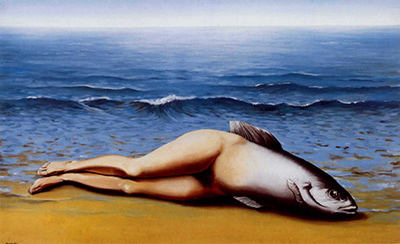The surreal art of René Magritte (1898-1967) is unique. Rather than merely create a bizarre and irrational world in his paintings he preferred instead to undertake a close examination of the idea of the visual image revealing its shortcomings and showing how much it depends on our figures of speech and thought.
He asks us whether the image gives rise to the thought or the thought to the image. Do we think what we see or do we see what we think?
The objects in his paintings are portrayed with careful realistic precision. But he undermines our confidence in this reality by means of a number of tricks or devices that disrupt our faith in his images of everyday and familiar objects. Two lovers kiss but with their faces covered with cloths (Les Amants). In a painting of a young nude woman a skull is shown instead of her face (The Spoiler).
A painting stands on an easel in front of the window yet the image in the painting matches exactly, and is indistinguishable from, the view through the window (The Human Condition). Magritte challenges our sense of the reality of what we see around us. “Collective Invention”, painted in 1934, is one such work. We are all familiar with the idea of a mermaid – half woman, half fish – and carry around with us our idea of how a mermaid should be represented. That, perhaps, is the “Collective Invention” of the title.
Magritte inverts that idea to create an image to subvert our preconceptions. Instead of the usual arrangement of the head, arms and torso of a woman and the tail of a fish Magritte confronts us with a creature composed of the legs of a woman and the head and body of a fish lying, as though washed up, on a beach. Magritte’s skill in rendering the transition from the warm tones of the human skin of the legs to the cold, silvery skin of the fish enables him to produce an image that is at once realistic and unreal. Gone is the seductive charm of the traditional mermaid and we are left with a disturbing image that is both sexually charged and yet cold and repellent.




